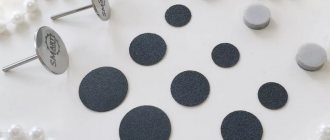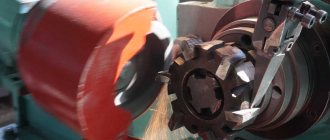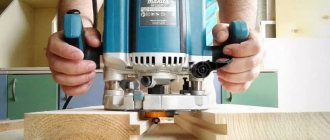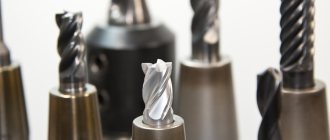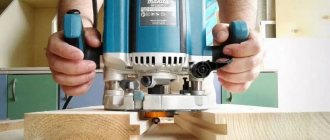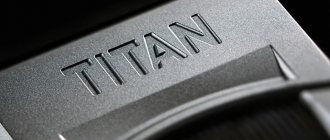Spread the love
This article will focus on the types of cutters that are used on hobby CNC machines. The number of tools available for industrial machines is staggering, too many for even one book, let alone one blog article. So, the main type of tools that CNC hobbyists use, and sometimes the only type they use, are end mills and ball end mills. Drill bits are often used if you are working with metals, but this article will only cover end mills and ball nose cutters.
I've compiled a list of common questions people ask and provided an answer that best addresses the concerns that CNC hobbyists might have.
End Mills
What is an end mill used for?
For a very simple answer, an end mill spins in a router spindle and moves across a piece of material (metal or other material), and rotating "blades" on the edge of the tool cut the material to produce the desired result.
Originally, an end mill was used to remove material using only the cutting flutes on its diameter side. Thus, this will require approaching the workpiece from the side, moving along the X and Y axes only to remove material with the side edge of the tool.
Fortunately, the end mill has evolved to have cutting edges on the bottom surface, greatly increasing its versatility and making it a work tool capable of handling most milling tasks.
Having cutting edges on the base of the tool allows it to sink into your material.
When combined with a CNC machine, the face milling operation can be used to create grooves, holes, contours, and profiles, to name just a few of the most common tasks.
The widespread availability of carbide end mills, as opposed to high-speed steel (less durable), increases their use for harder exotic materials or simply to increase life expectancy, making the additional expense more cost-effective, especially for hobbyists.
When used correctly and carefully, a carbide end mill can last quite a long time.
Can you drill with an end mill?
If it has cutting edges on the bottom, yes, you can drill with an end mill.
End mill with cutting edge at bottom
This is basically described as "plunging" and allows you to open the "inside" pocket without using another tool to open up space for the end mill to move.
This feature does not replace the use of a drill, and drilling a deep hole with an end mill is not recommended.
A deep hole can be milled with an end mill, using a tool with a smaller diameter than the required hole and programming the CNC to "spiral" down in a circle. This is the best way to create a hole with an end mill, with the added bonus of being able to fine-tune and adjust the final diameter.
What are dual flute end mills used for?
End mills with two flutes are known as slot cutters. They are mainly used for routing grooves or pockets.
Typical slot cutter
What is the difference between an end mill and a slot mill?
A slot mill is a two-flute version of an end mill. They are specially designed to be driven into the material in the Z axis when milling a groove, such as a keyway. Sometimes I call these cutters a “key cutter.”
Having only two flutes increases the space in the tool's helix, giving more room for chip removal.
This helps prevent the tool from clogging and breaking when plunged and gives the slot cutter an improved ability to plunge and mill a slot without breaking, hence the name.
Can the end mill be submerged?
Most end mills have cutting edges on the bottom surface that will allow you to dig into the material.
Plunge is typically performed at a slower feed rate than X and Y milling, and avoid going too deep before moving in the X and/or Y directions.
A plunge feedrate of about 10% of your X and Y feedrate would be a good starting point.
What is a counter cutter?
A back end mill is when the helix of a side flute is raked backwards. This will cause the chips to rise and move away from the workpiece, helping to prevent chip buildup and prevent tool breakage.
Most end mills are designed as an up-cut type.
The direction of the flute is the same as that of the drill, which forces the chips along the flute and out of the hole.
What is a Climb End Mill?
A downcut end mill is when the helix of the side flutes is inclined forward. This causes the material being removed to fall down. These types of tools are mainly used for softer materials such as wood and plastic.
A straight cut end mill with the flute pointing forward, unlike a standard end mill.
This design feature prevents the material from cracking or chipping at the top edge, improving finish and appearance.
The tool is still designed to rotate in the same direction.
How can you tell if an end mill has a center cut?
The cutting edges on the bottom edge will extend to the center.
Milling cutter WITHOUT central cutter
Some cutters will have opposing flutes that meet slightly off-center (asymmetrically). This helps the tool cut in the middle where the rotation speed is slowest.
How many grooves are needed to mill steel?
There is no special requirement for a certain number of grooves for milling steel. The number of grooves can determine what capabilities a tool can have, making it better for specific applications.
For example, spline cutters have two flutes and are designed for plunging.
High Feed End Mill
An eight-flute end mill will be able to cut faster using the same feed per tooth as a four-flute end mill.
Is aluminum easier to mill than steel?
Yes, it's much easier. Although trying to mill low quality aluminum can be frustrating. The aluminum you can buy at your local big box store is not ideal for machining. It is usually sticky and will clog and break end mills. It's too soft.
The ideal grades of aluminum for machining are hard alloys such as AMG6 or alloy D16T and the like.
Sometimes these types of alloys are called aerospace or aircraft grade, which is just a fancy way of saying they are machineable.
What is the best end mill for aluminum?
There are end mills designed specifically for aluminum. They usually have a steep rake angle and only two grooves. This is done to take advantage of the higher speeds and feeds that industrial aluminum machines can handle, i.e. very fast.
Carbide end mill designed for machining aluminum.
For amateur machines, these high spindle rotation and feed speeds are not possible, so using a conventional carbide end mill is perfectly acceptable and even preferable.
Best end mill for stainless steel?
A good quality carbide end mill will be the tool of choice for machining any carbide.
Just reduce the speed and feed to accommodate the harder grade and hope your hobby machine can handle it.
Best end mill for wood?
Double-edge and even single-edge end mills, small diameter ball end mills for processing complex terrain. There are also cutters for wood processing. Up and down cut styles to fit different densities of wood, etc.
Burr type end mill for wood
Wood lends itself well to machining, so try different styles and find what suits your needs.
Best end mill for plastic?
Single blade end mills are best for cutting plastics. This allows the machine to run at high speeds but still maintain an achievable feed rate for the required feed per tooth.
Single Flute End Mill
How do I know if my end mill is carbide?
Bring a magnet to it; it should have a very weak magnetic attraction. Also check to feel its weight. Carbide is extremely dense and should appear heavy in comparison to its size.
How long should a carbide end mill last?
In industrial settings, tool manufacturers sometimes provide an approximate amount of time that an end mill will cut a particular material. The time the cutter "sinks into the material", works as hard as it can and removes a lot of steel, this "life" can be less than an hour.
While an end mill can last a long time for hobby machining, you won't be putting much pressure on it at all, machines just aren't capable of that.
For example, I was doing "heavy" cutting on my 3018 engraving machine with a ⅛" carbide end mill, and the machine would grind all the way down without breaking the end mill. Which tells me that the end mill is stronger than the machine.
CONTROL METHODS
GOST 2679-2014 slotting and cutting cutters.
technical specifications 3.1. Tests of cutters for performance, average and established periods of durability are carried out on vertical milling machines using auxiliary tools that meet the standards of accuracy and rigidity established for them.
3.2. Tests of cutters should be carried out on workpieces made of steel grade 45 according to GOST 1050 with a hardness of 187 ... 207 HB.
3.3. As a cutting fluid, a 5% (by weight) solution of emulsol in water is used, with a flow rate of 6-8 l/min.
3.4. The total milling length when testing the performance of cutters should be for cutters with a diameter, mm:
from 2.0 to 2.5………………………………………………………………………………300
St. 2.5 » 6.0…………………………………………………………………………………. 400
»6,0 » 12,0……………………………………………………………………… 600
»12,0……………………………………………………………………………… 1000
3.5. After testing the cutters for performance, the cutting edges should not be chipped or chipped, and they should be suitable for further work.
3.6. Tests of cutters for performance, average and established periods of durability should be carried out at the cutting conditions specified in table. 2.
table 2
| Cutter diameter, mm | Cutting speed, v , m/min | Innings Sz , mm/tooth | Milling depth t , mm | Milling width IN , mm |
| From 2 to 4 | 20 | 0,01 | 0,3 | 3 |
| St. 4 » 8 | 25 | 0,02 | 0,5 | 5 |
| » 8 » 14 | 30 | 0,03 | 2,0 | 10 |
| » 14 » 18 | 35 | 0,04 | 3,0 | 10 |
| » 18 » 25 | 40 | 0,04 | 3,0 | 20 |
| » 25 » 42 | 40 | 0,06 | 4,0 | 20 |
| » 42 » 63 | 40 | 0,08 | 5,0 | 30 |
3.7. Testing of cutters for the average period of durability should be accelerated.
In an accelerated test of five cutters, wear on the main flank surface is measured after an operating time t
.
The time values t
and permissible average wear
h
must correspond to those indicated in the table. 3.
Table 3
| Cutter diameter, mm | t , min | h , min |
| From 2 to 4 | 6 | 0,08 |
| St. 4 » 8 | 8 | 0,10 |
| » 8 » 14 | 10 | 0,12 |
| » 14 » 18 | 12 | 0,15 |
| » 18 » 25 | 16 | 0,18 |
| » 25 » 42 | 16 | 0,18 |
| » 42 » 65 | 16 | 0,18 |
3.8. It is allowed to carry out tests for the average period of durability until the dullness criterion specified in table is achieved. .
Acceptance values of the average and established durability periods should not be less than those indicated in the table. 4.
Table 4
| Cutter diameter, mm | Acceptance value of durability period, min | |
| average | established | |
| From 2 to 4 | 17 | 7 |
| St. 4 » 8 | 23 | 9 |
| » 8 » 14 | 35 | 14 |
| » 14 » 18 | 45 | 18 |
| » 18 » 25 | 68 | 28 |
| » 25 » 42 | 68 | 28 |
| » 42 » 65 | 80 | 32 |
3.9. The hardness of cutters is determined according to GOST 9013.
3.10. The appearance of the cutters is controlled by inspection.
3.11. The roughness parameters of the cutter surfaces are checked by comparison using a magnifying glass LP-1-4´ in accordance with GOST 25706 with roughness samples in accordance with GOST 9378 or with standard tools having the values of the roughness parameters specified in paragraph .
3.12. When monitoring cutter parameters, control methods and means must be used, the error of which should not be more than:
- when measuring linear dimensions - the values specified in GOST 8.051;
— when checking the shapes and arrangement of surfaces — 25% of the tolerance value for the parameter being tested;
- when measuring angles - 35% of the tolerance value for the angle being tested.
Ball end mills
What is a spherical end?
A ball nose end mill is simply another name for a ball nose end mill. This type of cutter has a full radius at the end.
Typical ball end mill
There are also end mills with rounded ends, which have rounded corners smaller than the radius of the cutter.
What is a ball end mill used for?
There are several uses for a ball end mill, the most important being the ability to produce free-form curves. This allows the CNC machine to machine complex, flowing shapes to reproduce decorative designs.
Conical Ball End Mills
These end mills are ideal for machining reliefs and decorative items. The radius at the end may be very small for handling parts, but the taper will add great strength to prevent breakage.
Two Conical Ball End Mills
The taper will not allow you to mill a vertical surface, but will not be a problem, for example, for relief.
INFORMATION DATA
1. DEVELOPED AND INTRODUCED by the Ministry of Machine Tool and Tool Industry of the USSR
DEVELOPERS
DI. Semenchenko, Ph.D. tech. Sci. N.I. Minaeva; T.A. Lavrenova
2. APPROVED AND ENTERED INTO EFFECT by Resolution of the State Committee of Standards of the Council of Ministers of the USSR dated 06/09/71 No. 1104
3. Inspection period - 2000, inspection frequency - 10 years
4. The standard fully complies with ST SEV 109-79
5. INSTEAD GOST 8237-57 regarding milling cutters with a cylindrical shank, MN 409-65, MN 410-65
6. REFERENCE REGULATIVE AND TECHNICAL DOCUMENTS
| Designation of the referenced technical document | Item number |
| GOST 14034-74 | 8 |
| GOST 17024-82 | 11 |
| GOST 25334-94 | 7a |
| ISO 1641-1-78 | 2, 12 |
7. The validity period was removed by Decree of the State Standard of March 25, 1982 No. 1232
8. REISSUE (March 1998) with Amendments No. 1, 2, 3, 4, 5, 6, approved in February 1973, January 1977, March 1982, April 1985, March 1991. , September 1995 (IUS 2-73, 2-77, 6-82, 7-85, 6-91, 12-95)
- GOST R ISO/IEC 17025-2000 General requirements for the competence of testing and calibration laboratories
- GOST 17025-71 End mills with a cylindrical shank. Design and dimensions
- GOST R 52960-2008 Accreditation of forensic laboratories. Guidelines for the use of GOST R ISO/IEC 17025
- GOST R ISO/IEC 17025-2006 General requirements for the competence of testing and calibration laboratories
- GOST R ISO/IEC 17025-2000 General requirements for the competence of testing and calibration laboratories

